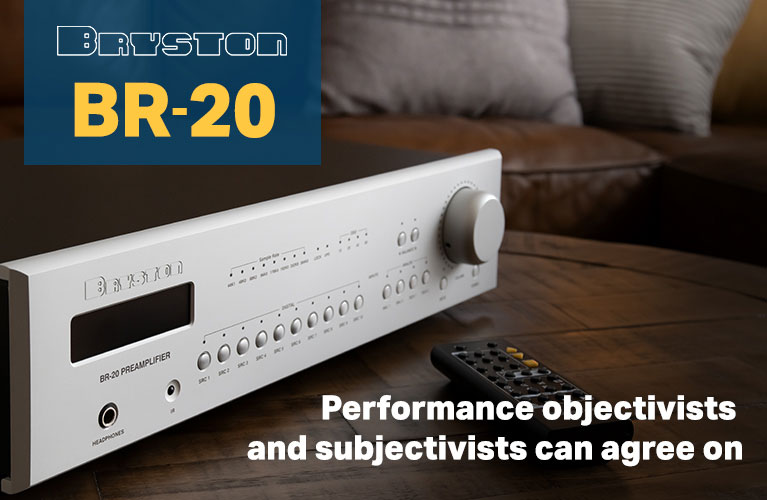Note: Measurements taken in the anechoic chamber at Canada's National Research Council can be found through this link.
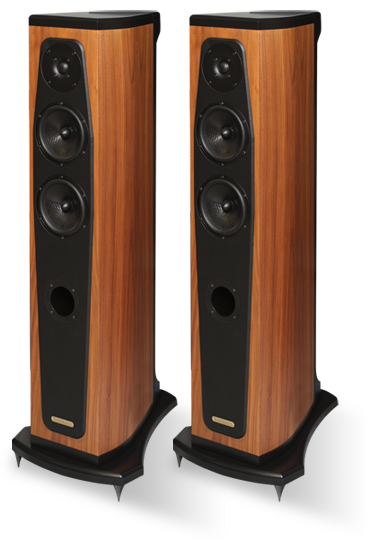 I think it’s best to approach any review subject with a healthy dose of skepticism, but with AudioSolutions’ Rhapsody 80 loudspeaker I found I’d dosed myself more than usual. I knew nothing about the company, which, I learned, had been founded in 2011, after a reported eight years of research into speaker design by owner and chief designer Gediminas Gaidelis. Then there’s the country AudioSolutions is based in: Lithuania. England, Canada, Denmark, and France have long histories of high-quality speaker design -- think B&W, KEF, Paradigm, PSB, Dynaudio, DALI, Focal, Cabasse -- but . . . Lithuania?
I think it’s best to approach any review subject with a healthy dose of skepticism, but with AudioSolutions’ Rhapsody 80 loudspeaker I found I’d dosed myself more than usual. I knew nothing about the company, which, I learned, had been founded in 2011, after a reported eight years of research into speaker design by owner and chief designer Gediminas Gaidelis. Then there’s the country AudioSolutions is based in: Lithuania. England, Canada, Denmark, and France have long histories of high-quality speaker design -- think B&W, KEF, Paradigm, PSB, Dynaudio, DALI, Focal, Cabasse -- but . . . Lithuania?
Still, I was game to try. After a lengthy review period that included listening, measurements, and plenty of e-mail correspondence with Gaidelis, my skepticism had been transformed into admiration for the Rhapsody 80, and a strong interest in what else this interesting company from a faraway place is and might be making.
Description
AudioSolutions debuted with the Rhapsody line, and now offers the lower-priced Euphony series as well. The 80, which sells for $4187 USD per pair (although AS as yet has no North American distributor), is the smallest Rhapsody floorstander. Above it in the line are the 130 and 200 floorstanders, and below it the 60 bookshelf model; fleshing out the series is the Rhapsody C center-channel speaker.
The Rhapsody 80 is a three-driver, two-way design whose drive-units comprise a 1” (25mm) silk-dome SEAS tweeter and two 6” (150mm) SEAS midrange-woofers that operate together, both augmented by a single front-firing port. On the rear panel is a single pair of binding posts.
Gaidelis told me that he prefers third-order crossover slopes, as in the 80, and that he likes to use the fewest components possible to achieve the greatest transparency and detail, but not so few as to sacrifice performance in other areas. Jantzen Audio parts are used throughout the crossover, which is wired point to point. The three supplied spikes provide the front baffle with a range of backtilt of about 8 degrees, to help offset the phase shift induced by the crossover.
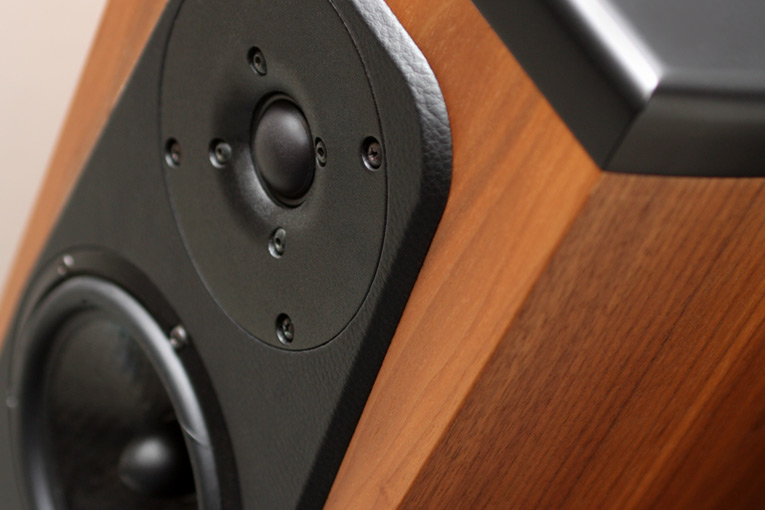
In designing a proper blend of the outputs of the upper- and lower-frequency drivers, Gaidelis looks for a flat overall frequency response and a good power response. But he says he won’t sacrifice a speaker’s sensitivity just to make something measure extraordinarily flat on axis -- there are room reflections, after all, that have a far more profound effect than a quarter- or half-decibel here or there.
With the Rhapsody 80 specifically, Gaidelis said he wanted to keep the sensitivity relatively high, and the load easy enough that even a tube amp of modest power could drive a pair of them. AudioSolutions rates the 80’s sensitivity at 91dB/2.83V/m, while the impedance is said to range from a minimum of 3.7 ohms at 190Hz to a maximum of 16 ohms at 64Hz.
 Gaidelis acknowledges that one can only get so much bass out of two 6” midrange-woofers. He’s tailored the response so that the Rhapsody 80 sounds relatively neutral overall, with bass that’s sufficiently deep but, more important to him, that sounds “uniform” with the rest of the audioband. (I learned through our e-mail exchange that Gaidelis is incredibly honest in his descriptions of how his speakers sound, and humble -- he explained precisely what he feels each speaker’s strengths and weaknesses are, which isn’t often the case with designers, many of whom want you to believe that their $4000/pair speaker outperforms anyone else’s at any price.) The Rhapsody 80’s in-room response is a claimed 39Hz-25kHz, which, based on my experience of it in my room and our measurements of it in the anechoic chamber of Canada’s National Research Council (NRC), is realistic.
Gaidelis acknowledges that one can only get so much bass out of two 6” midrange-woofers. He’s tailored the response so that the Rhapsody 80 sounds relatively neutral overall, with bass that’s sufficiently deep but, more important to him, that sounds “uniform” with the rest of the audioband. (I learned through our e-mail exchange that Gaidelis is incredibly honest in his descriptions of how his speakers sound, and humble -- he explained precisely what he feels each speaker’s strengths and weaknesses are, which isn’t often the case with designers, many of whom want you to believe that their $4000/pair speaker outperforms anyone else’s at any price.) The Rhapsody 80’s in-room response is a claimed 39Hz-25kHz, which, based on my experience of it in my room and our measurements of it in the anechoic chamber of Canada’s National Research Council (NRC), is realistic.
The cabinet is as attractive as it is impressive. It measures 39”H x 8.3”W (across the front baffle; the rear is narrower) x 14.8”D without plinth or spikes. (The front spikes are significantly thicker and taller than the single rear spike, to provide that backtilt.) Viewed from the top, the cabinet flares toward the front in a way that resembles a horn. Gaidelis said that he experimented with rectangular cabinets early in his research, but that this shape outperformed them, likely because of how the cabinets dissipate internal energy.
Gaidelis said that resonances can be better controlled by using different materials of varying thicknesses. The Rhapsody 80’s curved sidewalls are made of two layers of plywood, each 5mm thick, and an outer layer of MDF 10mm thick. The rear, top, and bottom walls are 50mm thick. He also said that building the 80’s cabinet is like building an airplane wing -- there’s a ribbed “skeleton” of MDF and plywood, on which are built the sides, front, back, top and bottom. The front baffle is adorned with artificial leather that looks pretty real. Gaidelis said that he chose artificial leather not to reduce cost, but because he doesn’t believe in killing animals to decorate a speaker.
The Rhapsody 80 is available in a White painted finish or one of five real-wood veneers: Zebrano, Sapeli, Santos Palisander, Walnut, and Smoked Oak. Each speaker, including plinth and spikes, weighs 55 pounds. No grille is supplied because Gaidelis feels that any grille would be detrimental to the sound. I agree, but I’d still like to have a grille, if only to protect the drivers.
For those who like their audio products to have a bespoke feel, vs. the exacting precision of state-of-the-art, high-volume manufacturing (think Apple’s products streaming off high-volume assembly lines in the Far East), it’s worth noting what Gaidelis said about the Rhapsody 80 in an e-mail: “The only part where CNC takes place is machining the ribs and front-panel shape. These parts should be cut in high precision. All other woodwork is done like in old days -- hands and hand tools. . . . We are still veneering our cabinets with veneer hammer. Veneer joining is done by hand too.”
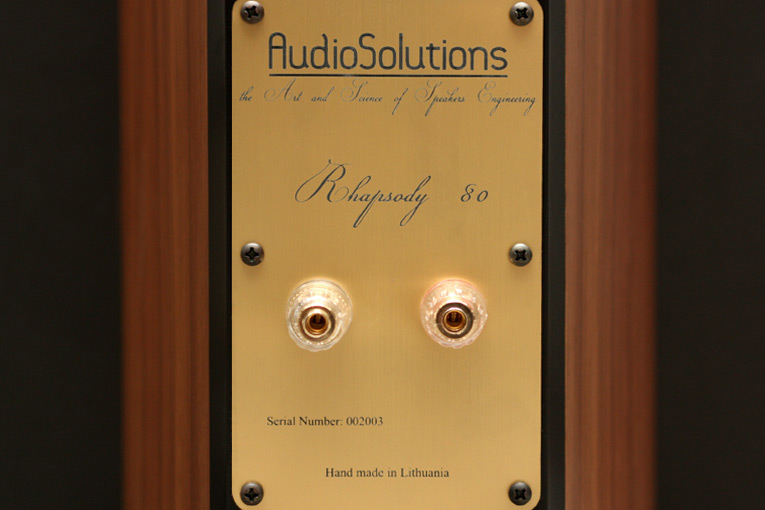
This means that AudioSolutions speakers don’t have quite the cosmetic refinement of, say, PSB’s Imagine T2 ($3500/pair) or KEF’s R500 ($2599.98/pair), both of which I recently reviewed. The PSB and KEF are respectively designed in Canada and England but are built entirely in China, with the pristine fit’n’finish of high-tech manufacturing. But the way AudioSolutions builds the Rhapsody 80 is not something I hold against the speaker; in fact, I like its handmade feel -- it gives the 80 a little more personality than most. As Jules said in Pulp Fiction, “Personality goes a long way.” But good sound goes further . . .
Sound
Given my lack of experience with AudioSolutions products, I had no idea what the Rhapsody 80s might sound like before I received them and set them up, but I do confess to having some concerns and preconceptions when I saw their three drivers and learned that the 80 was only a two-way design. Would those two midrange-woofers blend seamlessly with the tweeter, despite their differing distances from it?
I needn’t have worried -- once the music was playing, the sound projected from each set of three drivers was so cohesive that it seemed to be coming from a point source. The pair also projected a soundstage of excellent width, outstanding depth, and rock-solid image specificity. When I played “5 Days in May,” from Blue Rodeo’s Five Days in July (16-bit/44.1kHz FLAC, Discovery), the speaker end of the room became a soundstage that reached just past the outside edges of each speaker and a little bit past the front wall of my room. It was huge! The voices of Blue Rodeo’s two lead singers, Greg Keelor and Jim Cuddy, were rich in texture, their images carved precisely and holographically. So in terms of creating a credible soundstage with spot-on image specificity, the 80s fared far, far better than most speakers, regardless of price. They also were exceptionally transparent, doing an outstanding job of getting the sound out of the boxes -- that aural freedom that occurs when two speakers seem to “disappear” from the room, leaving no hint that they’re the actual sources of the sound. From the get-go, I was impressed.
The 80’s bass performance was similar to that of the PSB Imagine T2: quite full, pretty visceral, and impressively deep, reaching to just under 40Hz with enough authority and weight to make this moderately sized floorstander sound satisfyingly rich and full in a modest-sized room. This even held true when I used the 80s with a Copland CTA 506 stereo amp (90Wpc into 8 ohms) and JE Audio VM60 mono amps (60Wpc into 8 ohms). In contrast, I wouldn’t necessarily recommend tubes so freely for the Imagine T2, which is a little tougher to drive and less sensitive. But regardless of whether I was using solid-state or tube amps with the Rhapsody 80s, the drums in “5 Days in May” were forceful and deep, and the rich, weighty tones throughout “Mining for Gold” and “Misguided Angel,” the first two tracks of the Cowboy Junkies’ The Trinity Session (16/44.1 FLAC, RCA), were as prominent as through any similar-sized floorstander I’ve heard -- and far more so than through any stand-mounted two-way at any price. All told, the 80’s two midrange-woofers didn’t just do a great job of blending with the tweeter, they also did a very good job of moving lots of air and plumbing the bass depths -- so good that I can’t imagine most audiophiles wanting to use a subwoofer with these speakers.
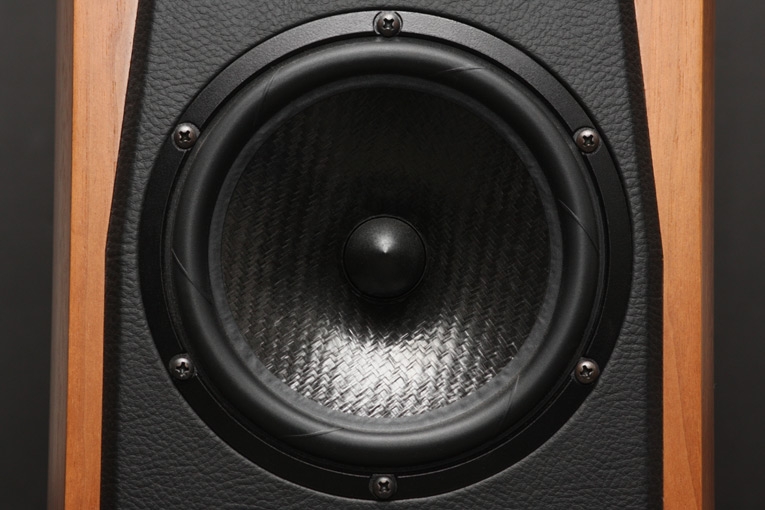
The 80s also had similar output capabilities to the T2, meaning that a pair could play reasonably loud in a typical room without strain -- even hard rock was reproduced well. If you have a huge room, though, the Rhapsody 80s’ output, just like that of the Imagine T2s, probably won’t be enough. You’ll need something bigger -- perhaps the Rhapsody 130.
The Rhapsody 80 wasn’t quite as tonally neutral as PSB’s very linear Imagine T2. But it wasn’t that far off, and to some ears might sound better overall, given how expertly it’s been voiced. In my book, neutrality is a great thing, but it’s also OK to slightly deviate from strict neutrality, though not so far as to sound unnatural.
Mostly, I noticed that the Rhapsody 80’s entire midrange region was a bit more forward than that of the ruler-flat T2, and its highs were a touch sweeter but also slightly less emphasized -- which, all told, made male and female voices sound a little more prominent, but not so much as to be in-your-face or unnatural. I actually preferred the 80’s little bits of midrange upfrontness and top-end tidiness to the more ruler-flat presentation of the Imagine T2, despite the fact that the PSB sounds slightly more sultry and smooth through the midrange; obviously, this deviation from neutrality wasn’t a bad thing for me. Interestingly, this kind of voicing of the midband and highs is reminiscent of Magico’s V2, which I reviewed a couple of years ago and which sold for $18,000/pair. Not surprisingly, the V2’s frequency-response measurements are strikingly similar to the Rhapsody 80’s; calling the 80 a poor man’s V2 wouldn’t be out of line, or slight the AudioSolutions one bit; it would be a compliment.
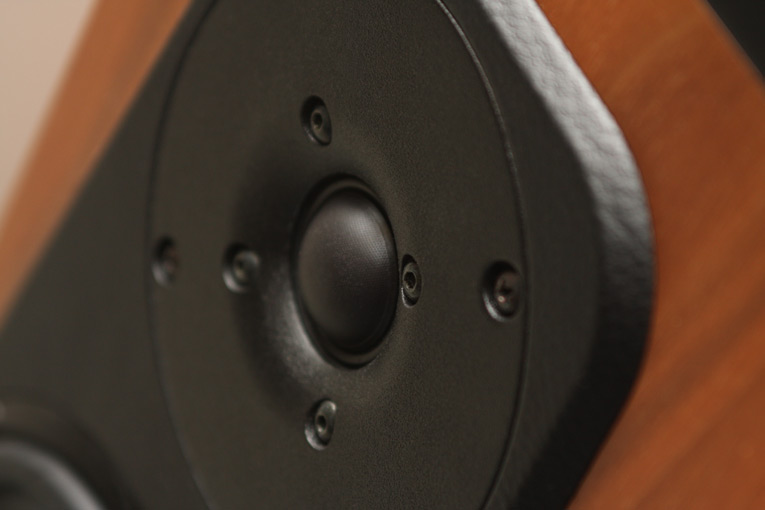
Detail from the bass through to the highs was also extremely good -- not quite V2 good, given that that speaker could unveil otherworldly detail, particularly in the bass and mids, but as good as any of the 80’s competitors that I’ve heard, including PMC’s twenty.24 ($6000/pair), which I reviewed in 2012 and praised for its midband clarity and transparency. The detail was easy to hear with a variety of recordings. For example, Blue Rodeo’s Greg Keelor went solo to record Gone in 1997, and that album’s “No Landing (Lucknow)” has been a favorite test track of mine for how realistic and natural Keelor’s voice sounds, and for how rich it is in texture and detail. The Rhapsody 80s nailed this recording as well as the twenty.24s do -- Keelor’s voice was superbly focused on the stage, sounding wonderfully textured and detailed, highly transparent, and very natural. Ditto for a topflight recording that fellow-writer S. Andrea Sundaram recently turned me on to: Noriko Ogawa playing Mozart piano sonatas (24/96, BIS/eClassical.com). Through the Rhapsody 80s it sounded exceedingly natural -- like a real piano in a real room, which is why S. Andrea wanted me to hear it -- and with tremendous transparency and surprising dynamic range, given the speaker’s size, price, and driver complement. All told, for its asking price, the Rhapsody 80 performed exceedingly well in my room. Color me impressed -- very impressed.
Conclusions
We all know the saying “one man can make a difference.” There’s a lot of truth to it, and Gediminas Gaidelis is proof. Although I’m not sure he and AudioSolutions can single-handedly put Lithuania on the same speaker-building map as England, Canada, Denmark, and France, the Rhapsody 80’s unique look, bespoke-like build, and topflight sound -- which hold up against some of the best affordably priced floorstanders available today -- have vanquished my skepticism. They’ve thoroughly convinced me that AudioSolutions is a company to be reckoned with, and that Gaidelis, though still relatively unknown, is a designer who knows his stuff. I look forward to hearing more of his speakers, as well as what he’ll be bringing to market in years to come.
But there’s no reason to wait for what might be. If you’re looking to spend anywhere up to $6000 on a pair of speakers, make sure that the AudioSolutions Rhapsody 80, at only two-thirds that price, is on your shopping list. If I were shopping today, it’s certainly a speaker I would strongly consider.
. . . Doug Schneider
das@soundstagenetwork.com
Associated Equipment
- Speakers -- KEF R500, PMC twenty.24, PSB Imagine T2
- Amplifiers -- Bryston 4B SST2, Copland CTA 506, Eximus S1, JE Audio VM60 (mono), Simaudio Moon Evolution 870A
- Preamplifiers -- Eximus DP1, JE Audio VL10.1, Simaudio Moon 350P, Moon Evolution 740P
- Digital-to-analog converters and digital sources -- Calyx Audio DAC 24/192 and Femto, Cambridge Audio Azur 851C, Eximus DP1, Simaudio Moon Evolution 650D
- Computer -- Sony Vaio laptop running Windows Vista and JRiver Media Center 17
- Digital interconnects -- AudioQuest Carbon and Diamond USB
- Analog interconnects -- Nirvana S-L, Nordost Valhalla
- Speaker cables -- Nirvana S-L
AudioSolutions Rhapsody 80 Loudspeakers
Price: $4187 USD per pair.
Warranty: Five years parts and labor.
AudioSolutions
Kovo11-osios 47-92
Vilnius, Grigiskes LT-27122
Lithuania
Phone: +37066226342
E-mail: info@audiosolutions.lt
Website: www.audiosolutions.lt






















